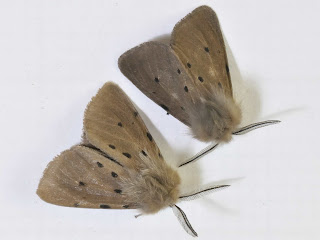In addition to the mines of
Eriocrania sangii (see earlier post), Friday afternoon's dog-walk to the Westcott Venture Park entrance produced an example of
Aspilapteryx tringipennella which was disturbed from the grass. Yesterday's walk to the same area was taken later, at dusk, and I found activity from at least half a dozen small micros at one particular spot around some long grass beneath a line of poplars. One was brought home and it proved to be
Elachista rufocinerea which doesn't seem to be known from this part of the county, so that was a nice find (there are 24 records from nine different sites in Bucks and it is likely to be under-recorded). The latter doesn't yet feature on my garden list so its nice to know that it is active only a few hundred metres away!
 |
| Aspilapteryx tringipennella, Westcott 24th April |
 |
| Elachista rufocinerea, Westcott 25th April |
Yesterday in the garden I found a smart hairy caterpillar on blackthorn. The chances are that at only 15mm it is a mid-instar, so despite being well-marked it is perhaps not surprising that, yet again, the new field guide failed to provide an obvious ID, but I think it may perhaps be Pale Eggar. Does anyone recognise it?
 |
| Caterpillar, Westcott 25th April |
 |
| Caterpillar, Westcott 25th April |
Finally, another nice find in the garden yesterday was a very early web of caterpillars from one of the
Yponomeuta species on our well-established spindle, the first occasion I've ever found larvae on it. It was not possible to count them accurately but there appear to be about 30 altogether. The chances are that they will be
Yponomeuta cagnagella and I shall try to rear them through to be sure. It would be a new species for the garden because I usually don't bother recording that group (
padella/
malinellus/
cagnagella) which are indistinguishable as adults. Apart from
cagnagella, two others feed on spindle but I've only had
plumbella in the garden a couple of times and the last occasion was nine years ago (that one is easily identifiable as an adult anyway) while
irrorella is a rare species limited to the south coast.
 |
| Yponomeuta sp larval web, Westcott 25th April |
Dave Wilton
Westcott, Bucks















 My other interesting experience has been spotting a male Emperor late yesterday afternoon, flying slowly and rather clumsily in the warm sunshine around our Romneya poppy where he settled down. He has been there ever since - sequence of photos below - unmoved by light, dark, the moth trap (about 50 metres away) and a light frost, evidenced by the effect, left, of my early morning mug of tea. Martin Wainwright, Thrupp, Oxon
My other interesting experience has been spotting a male Emperor late yesterday afternoon, flying slowly and rather clumsily in the warm sunshine around our Romneya poppy where he settled down. He has been there ever since - sequence of photos below - unmoved by light, dark, the moth trap (about 50 metres away) and a light frost, evidenced by the effect, left, of my early morning mug of tea. Martin Wainwright, Thrupp, Oxon 






